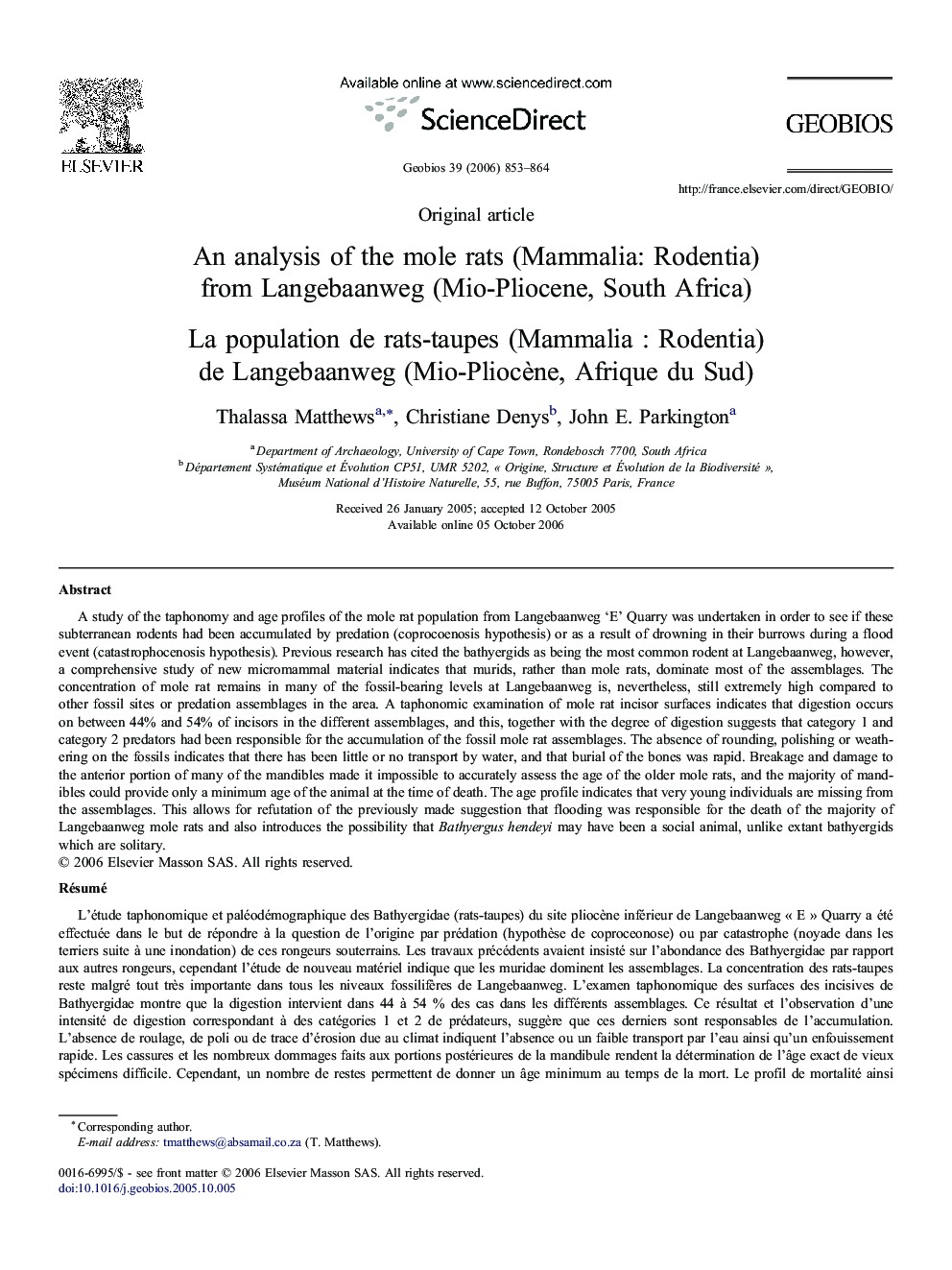| کد مقاله | کد نشریه | سال انتشار | مقاله انگلیسی | نسخه تمام متن |
|---|---|---|---|---|
| 4748627 | 1360127 | 2006 | 12 صفحه PDF | دانلود رایگان |

A study of the taphonomy and age profiles of the mole rat population from Langebaanweg ‘E’ Quarry was undertaken in order to see if these subterranean rodents had been accumulated by predation (coprocoenosis hypothesis) or as a result of drowning in their burrows during a flood event (catastrophocenosis hypothesis). Previous research has cited the bathyergids as being the most common rodent at Langebaanweg, however, a comprehensive study of new micromammal material indicates that murids, rather than mole rats, dominate most of the assemblages. The concentration of mole rat remains in many of the fossil-bearing levels at Langebaanweg is, nevertheless, still extremely high compared to other fossil sites or predation assemblages in the area. A taphonomic examination of mole rat incisor surfaces indicates that digestion occurs on between 44% and 54% of incisors in the different assemblages, and this, together with the degree of digestion suggests that category 1 and category 2 predators had been responsible for the accumulation of the fossil mole rat assemblages. The absence of rounding, polishing or weathering on the fossils indicates that there has been little or no transport by water, and that burial of the bones was rapid. Breakage and damage to the anterior portion of many of the mandibles made it impossible to accurately assess the age of the older mole rats, and the majority of mandibles could provide only a minimum age of the animal at the time of death. The age profile indicates that very young individuals are missing from the assemblages. This allows for refutation of the previously made suggestion that flooding was responsible for the death of the majority of Langebaanweg mole rats and also introduces the possibility that Bathyergus hendeyi may have been a social animal, unlike extant bathyergids which are solitary.
RésuméL'étude taphonomique et paléodémographique des Bathyergidae (rats-taupes) du site pliocène inférieur de Langebaanweg « E » Quarry a été effectuée dans le but de répondre à la question de l'origine par prédation (hypothèse de coproceonose) ou par catastrophe (noyade dans les terriers suite à une inondation) de ces rongeurs souterrains. Les travaux précédents avaient insisté sur l'abondance des Bathyergidae par rapport aux autres rongeurs, cependant l'étude de nouveau matériel indique que les muridae dominent les assemblages. La concentration des rats-taupes reste malgré tout très importante dans tous les niveaux fossilifères de Langebaanweg. L'examen taphonomique des surfaces des incisives de Bathyergidae montre que la digestion intervient dans 44 à 54 % des cas dans les différents assemblages. Ce résultat et l'observation d'une intensité de digestion correspondant à des catégories 1 et 2 de prédateurs, suggère que ces derniers sont responsables de l'accumulation. L'absence de roulage, de poli ou de trace d'érosion due au climat indiquent l'absence ou un faible transport par l'eau ainsi qu'un enfouissement rapide. Les cassures et les nombreux dommages faits aux portions postérieures de la mandibule rendent la détermination de l'âge exact de vieux spécimens difficile. Cependant, un nombre de restes permettent de donner un âge minimum au temps de la mort. Le profil de mortalité ainsi obtenu démontre que les individus très jeunes sont absents. Cela est un argument contre l'hypothèse de concentration par piégeage des individus dans leurs terriers lors d'une crue. Enfin, la relative abondance de Bathyergus hendeyi dans tous les niveaux suggère un mode de vie plutôt social contrairement à l'actuel.
Journal: Geobios - Volume 39, Issue 6, November–December 2006, Pages 853–864